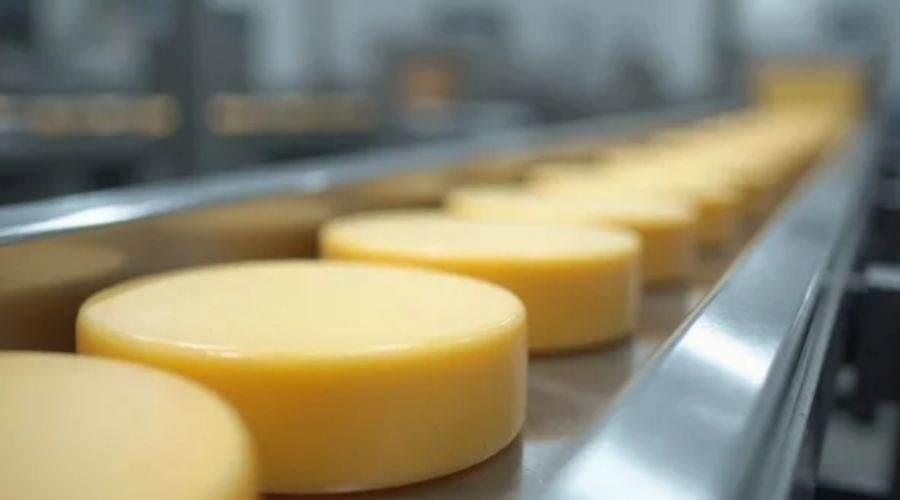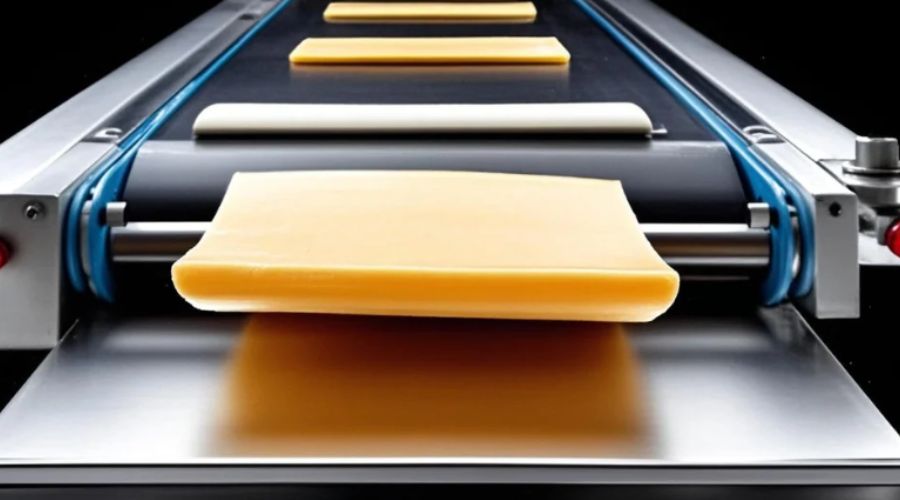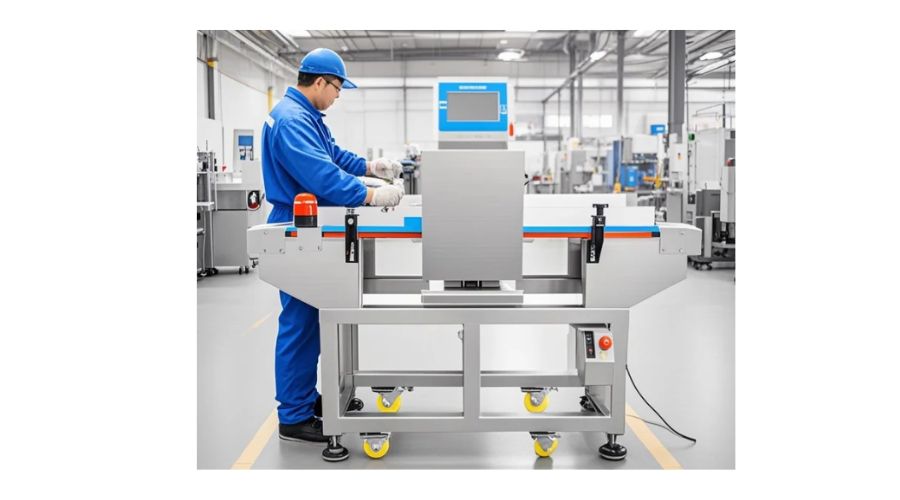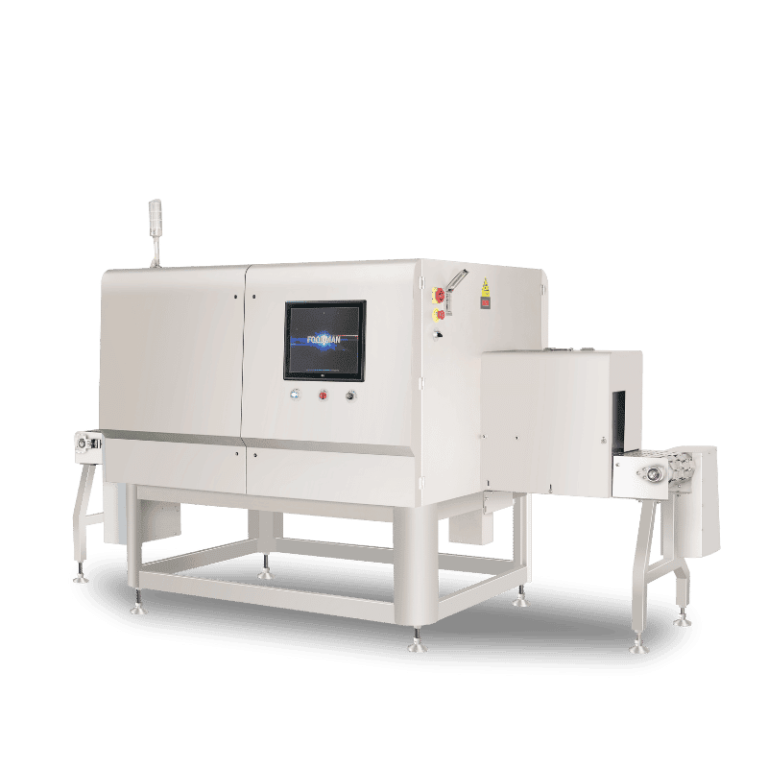Introduction — Safeguarding Dairy from Metal Hazards
Growth and Complexity of Dairy Production: Multiple Product Formats (Cheese Blocks, Shredded Cheese, Milk Powder)
The dairy industry has seen remarkable growth over the past decade, driven by rising global demand for products like cheese blocks, shredded cheese, and milk powder. Each of these formats presents unique challenges in ensuring consistent food safety. Dense cheese blocks require careful handling to avoid contamination, shredded cheese poses risks due to its irregular shapes, and milk powder—being highly particulate—can carry contaminants that are difficult to detect.
To address these challenges, modern producers increasingly rely on food industry metal detectors. Understanding how a metal detector works in these different product forms is crucial. By strategically placing metal detector for food production line systems at critical control points, manufacturers can detect metallic contaminants before products reach consumers.

Rising Regulatory and Consumer Expectations for Food Safety
Consumers today expect dairy products to be not only delicious but also completely safe. Similarly, regulatory agencies enforce strict standards to ensure product integrity. Compliance with HACCP, ISO, and local food safety regulations is mandatory, and failing to meet these standards can lead to costly recalls and reputational damage.
This makes the role of metal detector in food industry systems even more important. These detectors provide an automated, real-time safeguard against metallic contamination, enabling producers to maintain high-quality standards. Knowing what do metal detectors detect helps manufacturers prepare for potential hazards, ensuring that no metal fragments—ferrous, non-ferrous, or stainless steel—escape inspection.
Purpose: Explore the Evolving Role of Metal Detector for Food Production Lines in Cheese and Milk Powder Processing
This article aims to explain how does a metal detector work and why it is an indispensable tool for dairy producers. Essentially, how a metal detector works involves generating an electromagnetic field that can identify metallic objects within the product as it passes through the detection tunnel. Once a contaminant is detected, the system triggers automatic rejection, preventing unsafe products from continuing along the production line.
For cheese and milk powder, understanding what can a metal detector detect allows producers to choose equipment with appropriate sensitivity levels. Modern food industry metal detectors not only catch metallic fragments efficiently but also support traceability and compliance, making them a cornerstone of modern food safety protocols in dairy production.
Unique Challenges of Metal Contamination in Dairy
Product-Specific Risks
Different dairy products present unique challenges for maintaining food safety. Cheese, with its dense and irregular shapes, can easily hide small metallic contaminants during slicing, shredding, or packaging. Additionally, variable moisture content in cheese can affect the sensitivity of metal detection systems, making it crucial to use advanced metal detector for food production line technology that adapts to these variations.
Milk powder poses a different set of risks. Its fine particulate nature and high flow rate make it susceptible to dust contamination, which can obscure metallic fragments. Proper integration of food industry metal detectors ensures that even minute particles of ferrous, non-ferrous, or stainless steel are reliably identified. Understanding what do metal detectors detect and what can a metal detector detect helps dairy producers select the right detection system for each product type.
Sources of Metal Contamination
Metal contaminants in dairy products can originate from multiple sources across the production process. Common sources include:
Machinery: Wear and tear on mixers, conveyors, slicers, and packaging equipment can introduce metal fragments. Knowing how a metal detector works allows operators to strategically position detection points where contamination is most likely.
Packaging Materials: Metal staples, clips, or fragments from packaging machinery can inadvertently mix with the product.
Ingredient Suppliers: Contaminants can enter through raw materials such as milk powders or cheese curds.
Cross-Contamination: Shared equipment and processing areas can introduce metals from other production lines.
By understanding how does a metal detector work, dairy producers can mitigate risks at each potential source, ensuring that contaminated products are caught before leaving the facility. Metal detector in food industry applications provide continuous monitoring, making this process efficient and reliable.
Impacts on Product Quality, Consumer Safety, and Brand Integrity
Even a small metal fragment in dairy products can have severe consequences. Physical contamination can harm consumers, resulting in injuries and potential lawsuits. From a product quality perspective, metallic fragments compromise integrity and can lead to recalls.
The presence of contaminants also damages brand reputation. Consumers expect dairy products to meet strict food safety standards, and failure to do so can lead to lost trust and market share. Using advanced metal detector for food production line systems ensures that manufacturers know what do metal detectors detect and what can a metal detector detect, maintaining product safety and protecting the brand.
Modern food industry metal detectors not only prevent contamination but also support compliance with regulatory standards, giving producers a reliable safeguard to uphold consumer trust while maintaining operational efficiency.
Advanced Metal Detection Technology
Multi-Frequency and Tunable Detection for Diverse Dairy Products
Dairy production involves a wide range of products, from dense cheese blocks to fine milk powders. Each product type presents unique challenges for metal detection. Modern metal detector for food production line systems employ multi-frequency detection, allowing operators to adjust settings based on the product’s density, moisture content, and packaging.
By understanding how a metal detector works in different conditions, producers can detect a broader spectrum of contaminants. Knowing what do metal detectors detect and what can a metal detector detect ensures that both ferrous and non-ferrous metals, including stainless steel, are reliably identified across all dairy products. This tunable approach maximizes food safety while minimizing false alarms.
AI-Assisted Detection for Reducing False Positives
Traditional metal detection systems can sometimes misinterpret product properties, leading to unnecessary rejects. Advanced food industry metal detectors now integrate AI algorithms to analyze product signals in real-time.
By understanding how does a metal detector work, AI can differentiate between actual metallic contaminants and benign product variations, reducing false positives. This ensures smoother production flow, less waste, and consistent product safety. Knowing what can a metal detector detect in combination with AI technology allows manufacturers to maintain high standards without compromising efficiency.
How Food Industry Metal Detectors Work in Real-Time Production
In dairy processing, speed and accuracy are critical. A metal detector in food industry works by generating an electromagnetic field in the detection tunnel. When a metallic object passes through, it disrupts the field, triggering an immediate response.
Understanding how the metal detector works helps operators position detection systems at key points, such as after mixing, shredding, or packaging. Real-time detection ensures that contaminated cheese or milk powder is automatically removed, maintaining food safety and minimizing production downtime. Learning how a metal detector works also enables quick troubleshooting and system optimization.

Data Tracking and Traceability for Compliance and Recall Management
Modern metal detector for food production line solutions provide detailed data logging and traceability features. Every detection event is recorded, including type of contaminant, detection location, and time stamp.
This data supports compliance with international food safety standards and simplifies recall management if contamination occurs. Understanding what do metal detectors detect and how does a metal detector work in this context ensures that manufacturers can provide clear, verifiable evidence of safety checks, protecting both consumers and brand integrity.
Strategic Integration of Metal Detectors in Dairy Lines
Placement Considerations
Proper placement of metal detector for food production line systems is crucial for maximizing contaminant detection without disrupting workflow. In milk powder production, detectors are ideally installed post-grinding and post-blending, where fine particulate and ingredient mixing could introduce metallic fragments. For cheese, metal detectors are best positioned before cutting or shredding and after packaging to catch any contaminants introduced during processing or handling.
Understanding how a metal detector works and what do metal detectors detect allows operators to choose the right detection points for each product type. By knowing what can a metal detector detect, manufacturers ensure ferrous, non-ferrous, and stainless steel contaminants are reliably intercepted, reinforcing food safety across the production line.
Synchronization with Automation and Other Inspection Technologies
Modern dairy production lines often combine multiple inspection and automation systems. Food industry metal detectors can be synchronized with checkweighers, X-ray systems, and robotic sorting devices to create a seamless, fully automated quality control process.
Knowing how does a metal detector work helps operators integrate it into production software for real-time alerts, automated rejection, and data logging. This coordination not only ensures accurate detection of metal detector in food industry hazards but also maintains production speed and operational efficiency.
Preventing Contamination While Maintaining Production Efficiency
One of the key advantages of advanced metal detector for food production line technology is its ability to safeguard products without slowing down the production process. By understanding how the metal detector works, operators can fine-tune sensitivity levels to catch even tiny metal fragments while avoiding unnecessary rejects.
Knowing what do metal detectors detect and what can a metal detector detect allows dairy producers to maintain high throughput while guaranteeing food safety. Strategically integrated food industry metal detectors prevent contamination risks and ensure that every block of cheese or bag of milk powder meets regulatory standards and consumer expectations.
Comparative Analysis: Metal Detection vs. Other Contaminant Inspection
Limitations of Metal Detection in Dairy
While metal detector for food production line systems are highly effective at identifying ferrous, non-ferrous, and stainless steel contaminants, they do have limitations. Low-density foreign materials, such as plastic fragments, glass shards, or wood pieces, can pass through undetected.
Understanding how a metal detector works and what do metal detectors detect is crucial to acknowledge these limitations. By knowing what can a metal detector detect, dairy producers can make informed decisions about when additional inspection technologies are necessary to maintain comprehensive food safety across cheese, milk powder, and other dairy products.
Complementary Technologies: X-Ray Inspection, Vision Systems, and Weight Checks
To address the limitations of metal detection, many dairy operations integrate food industry metal detectors with complementary inspection technologies. X-ray systems can detect both metallic and non-metallic contaminants, while vision inspection systems identify product defects or foreign objects on surfaces. Checkweighers ensure correct portion sizes and detect missing or excess ingredients.
Understanding how does a metal detector work allows operators to strategically combine these systems with metal detector in food industry applications, creating a multi-layered defense that ensures both product integrity and regulatory compliance.
Hybrid Inspection Strategies for Comprehensive Dairy Safety
A hybrid approach—combining metal detector for food production line, X-ray, vision systems, and weight checks—offers the most robust protection for dairy products. By strategically placing each technology according to risk points, manufacturers can minimize false negatives while maximizing detection efficiency.
Knowing how the metal detector works and understanding what do metal detectors detect ensures that all potential hazards, from metal fragments to low-density contaminants, are identified before products reach consumers. Such hybrid inspection strategies reinforce food safety, maintain product quality, and protect both brand reputation and consumer trust in the competitive dairy market.
Best Practices for Dairy Metal Detection
Calibration and Sensitivity Optimization for Cheese and Milk Powder
To ensure optimal performance, metal detector for food production line systems must be routinely calibrated and sensitivity levels optimized according to product characteristics. Cheese blocks, shredded cheese, and milk powder each have unique densities, moisture content, and particle sizes that can affect detection. Understanding how a metal detector works allows operators to adjust sensitivity so that even tiny ferrous, non-ferrous, or stainless steel fragments are reliably detected. Regular testing of what do metal detectors detect and verification of what can a metal detector detect are essential steps for maintaining food safety and preventing contaminated products from leaving the production line.

Staff Training for Effective Operation and Quick Response
Even the most advanced food industry metal detectors rely on skilled personnel for effective operation. Staff should be trained on how the metal detector works, including understanding alerts, system diagnostics, and the types of contaminants the equipment can identify. Proper education ensures quick responses to contamination events, minimizing product loss and maintaining food safety standards. Training also includes understanding how does a metal detector work within the dairy production environment and knowing what do metal detectors detect, ensuring the team can operate the metal detector in food industry systems with confidence and efficiency.
Continuous Performance Monitoring and Regular System Audits
Maintaining high reliability requires continuous monitoring and periodic audits of metal detector for food production line systems. Data logging and inspection records allow teams to track trends in detection performance and identify potential issues before they affect product safety. Understanding how a metal detector works helps interpret these data points, ensuring that what can a metal detector detect remains aligned with production goals and regulatory requirements. Continuous monitoring, coupled with regular maintenance and audits, keeps food industry metal detectors operating at peak efficiency, providing consistent protection across all dairy products and reinforcing overall food safety.
Emerging Trends and Innovations
Smart Metal Detectors with IoT Connectivity
The latest metal detector for food production line systems are increasingly equipped with IoT capabilities. These food industry metal detectors can transmit real-time detection data to centralized dashboards, allowing operators to monitor how a metal detector works across multiple production lines simultaneously. Understanding what do metal detectors detect and what can a metal detector detect in this connected environment enables quick decision-making and proactive intervention, enhancing overall food safety management in dairy facilities.
Predictive Maintenance and AI-Driven Detection Analytics
AI-assisted analytics are revolutionizing the way metal detector in food industry systems are maintained. By analyzing patterns in detection data, operators can anticipate equipment wear, reduce downtime, and optimize sensitivity settings. Understanding how does a metal detector work and how how the metal detector works under various product conditions allows predictive algorithms to detect anomalies before they result in missed contaminants. This intelligent approach ensures that food industry metal detectors consistently identify even challenging contaminants, preserving food safety and minimizing operational disruptions.
Sustainability and Reducing Product Waste Through Precise Detection
Advanced metal detector for food production line systems contribute to sustainability by minimizing product waste. With AI-enhanced detection and precise calibration, manufacturers can distinguish true metal contaminants from false positives. Knowing what do metal detectors detect and what can a metal detector detect enables high-accuracy sorting, ensuring only genuinely compromised products are rejected. This approach not only protects consumers but also supports food safety goals while reducing unnecessary waste and improving overall production efficiency.
Conclusion — Ensuring Safe and High-Quality Dairy Products
Metal Detection as a Core Component of Modern Dairy Food Safety
In today’s dairy industry, metal detector for food production line systems are no longer optional—they are a core component of comprehensive food safety strategies. Understanding how a metal detector works enables manufacturers to efficiently identify metallic contaminants in products like cheese and milk powder. By knowing what do metal detectors detect and what can a metal detector detect, dairy producers can prevent physical hazards, avoid costly recalls, and maintain consumer trust. Proper deployment of food industry metal detectors ensures that each batch leaving the production line meets the highest safety standards.
Balancing Operational Efficiency with Rigorous Contamination Control
Integrating metal detector in food industry solutions must balance strict contamination control with production efficiency. Understanding how the metal detector works allows operators to optimize sensitivity settings for diverse dairy products without causing unnecessary production delays. Advanced systems help identify contaminants quickly and accurately, minimizing waste while maintaining high throughput. Knowing how does a metal detector work and how a metal detector works in real-time operations ensures that food industry metal detectors provide consistent protection without compromising efficiency.
Investing in Next-Generation Metal Detectors in Food Industry for Long-Term Compliance and Brand Protection
Investing in advanced metal detector for food production line technologies is essential for long-term compliance and safeguarding brand reputation. Modern detectors offer AI-assisted detection, multi-frequency scanning, and automated traceability, which improve how a metal detector works and expand the range of contaminants they can identify. Understanding what do metal detectors detect and what can a metal detector detect helps dairy manufacturers ensure regulatory compliance and protect consumers. By prioritizing these systems, companies reinforce both food safety and brand integrity, securing a competitive advantage in the global dairy market.

FAQ
Q1: Where should metal detectors be placed in dairy production lines?
A2: Placement depends on product type: post-grinding and blending for milk powder, pre-cutting/shredding and post-packaging for cheese, to catch potential metal fragments at critical control points.
Q2: Can metal detectors replace other inspection technologies?
A2: No. While metal detectors are highly effective for metallic contaminants, X-ray inspection, vision systems, and checkweighers complement them for comprehensive dairy safety.
Q3: How do modern metal detectors support traceability and compliance?
A3: They log every detection event with timestamps, product details, and detection type, aiding in audits, regulatory compliance, and recall management.


